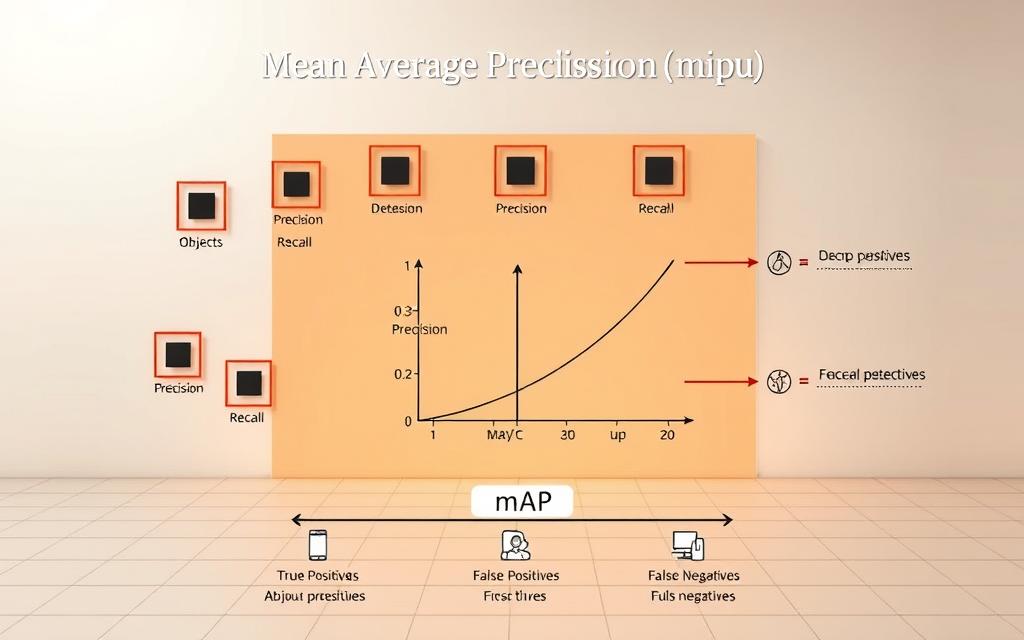In the world of machine learning, evaluating the performance of models is crucial. One key metric used in object detection tasks is Mean Average Precision (MAP). This metric helps measure how accurately a model identifies and locates objects within an image.
MAP plays a vital role in benchmarks like COCO and Pascal VOC, where it compares the effectiveness of popular object detection systems such as YOLO and Faster R-CNN. Its ability to balance precision and recall makes it a reliable tool for assessing model performance.
From autonomous vehicles to medical imaging, MAP is widely used in real-world applications. Platforms like V7 simplify the process of building and training detection models, offering access to over 65 free datasets. For beginners, understanding MAP is a stepping stone to mastering machine learning evaluation techniques.
Introduction to Mean Average Precision (MAP) in Deep Learning
Mean Average Precision (MAP) stands out as a critical evaluation tool. It combines precision and recall into a single performance score, making it a reliable metric for complex tasks. Unlike basic accuracy, MAP provides a more nuanced view of model effectiveness.
In fields like medical imaging, where both false positives and negatives matter, MAP is indispensable. For example, in cancer detection, a high MAP score ensures that the model accurately identifies abnormalities while minimizing errors.
The COCO 2017 benchmark calculates MAP across 80 classes and 10 IoU thresholds, ranging from 0.5 to 0.95. This comprehensive approach ensures that models are evaluated under varying conditions, reflecting real-world scenarios.
Object detection tasks require specialized evaluation because they involve both bounding box accuracy and classification. Basic accuracy metrics fall short in capturing these dual requirements. MAP addresses this gap by balancing precision and recall effectively.
Historically, MAP evolved from the PASCAL VOC benchmarks to the more advanced COCO standards. This progression reflects the growing complexity of detection tasks and the need for robust evaluation methods.
In real-world applications, MAP plays a crucial role. For instance, autonomous vehicles require a MAP score greater than 0.8 for safe deployment. This ensures that the system can accurately detect and respond to obstacles in dynamic environments.
The precision-recall curve serves as the visual foundation for MAP calculations. It illustrates the trade-off between precision and recall, helping developers fine-tune their models for optimal performance.
| Metric | Focus | Use Case |
|---|---|---|
| Basic Accuracy | Overall correctness | Simple classification tasks |
| MAP | Precision and recall balance | Complex object detection |
What Is MAP in Deep Learning?
MAP serves as a cornerstone for assessing object detection models effectively. It combines precision and recall into a single metric, providing a comprehensive evaluation of performance. This makes it indispensable for tasks like object detection and information retrieval.
Understanding the Basics of MAP
Average Precision (AP) is the area under the precision-recall curve. It measures how well a model balances precision and recall at different thresholds. For multi-class tasks, Mean Average Precision (mAP) is calculated as the mean of AP across all classes.
In the COCO dataset, mAP is computed across 80 classes. The formula is: mAP = (1/N)ΣAP@k, where N is the number of classes. This ensures a robust evaluation of model performance across diverse scenarios.
AP calculation often uses the trapezoidal integration method. This approach breaks down the precision-recall curve into smaller trapezoids, summing their areas for an accurate AP score.
Thresholds like [email protected] and [email protected] are commonly used. [email protected] is less strict, while [email protected] requires higher precision. Comparing these thresholds helps fine-tune models for specific applications.
Single-class AP focuses on one category, while multi-class mAP evaluates all categories simultaneously. This distinction is crucial for understanding model performance in complex tasks.
Here’s a practical code snippet for AP calculation using sklearn.metrics:
from sklearn.metrics import average_precision_score
y_true = [0, 1, 1, 0, 1]
y_scores = [0.1, 0.4, 0.35, 0.8, 0.7]
ap_score = average_precision_score(y_true, y_scores)
print("AP Score:", ap_score)
Common misinterpretations include confusing AP with mAP. AP applies to single classes, while mAP averages AP across multiple classes. Understanding this difference is key to accurate evaluation.
| Metric | Focus | Use Case |
|---|---|---|
| AP | Single class | Binary classification |
| mAP | Multiple classes | Object detection |
For a deeper dive into MAP, check out this complete guide.
Key Components of MAP: Confusion Matrix, IoU, Precision, and Recall
Evaluating model performance relies on understanding key components like the confusion matrix and IoU. These metrics provide a detailed view of how well a model identifies and classifies objects. Together with precision and recall, they form the foundation of Mean Average Precision (MAP).
Confusion Matrix: True Positives, False Positives, and More
The confusion matrix breaks down predictions into four categories: true positives (TP), false positives (FP), true negatives (TN), and false negatives (FN). For example, in a pedestrian detection system, TP=84 means 84 pedestrians were correctly identified, while FP=16 indicates incorrect detections.
False negatives (FN=9) represent missed detections, such as undetected tumors in medical imaging. This matrix helps identify areas for improvement, ensuring models balance accuracy and coverage effectively.
Intersection over Union (IoU): Measuring Bounding Box Accuracy
IoU measures the overlap between predicted and ground truth bounding boxes. The formula is: IoU = Area of Overlap / Area of Union. A score of 0.3 indicates poor alignment, while 0.85 reflects excellent accuracy.
In autonomous driving, a 5% change in the IoU threshold can significantly impact MAP scores. This highlights the importance of selecting the right threshold for specific applications.
Precision and Recall: Balancing Accuracy and Coverage
Precision measures the accuracy of positive predictions, while recall evaluates how many actual positives were detected. For instance, in medical diagnostics, high precision ensures fewer false positives, while high recall minimizes missed cases.
Type I errors (false positives) and Type II errors (false negatives) are critical in fields like healthcare. Balancing these errors ensures models are both accurate and reliable.
How to Calculate Mean Average Precision (MAP)
Understanding how to calculate Mean Average Precision (MAP) is essential for evaluating object detection models. This process involves analyzing the precision-recall curve, computing average precision, and selecting appropriate thresholds. Let’s break it down step by step.
Precision-Recall Curve: Visualizing Model Performance
The precision-recall curve plots precision (y-axis) against recall (x-axis) across different confidence thresholds. This visual tool helps developers understand the trade-off between precision and recall. For example, a model with high precision but low recall may miss many true positives.
In the COCO benchmark, the curve is used to evaluate models across 80 classes. The area under this curve represents the average precision, providing a single metric for performance assessment.
Calculating Average Precision (AP)
To calculate map, start by generating prediction scores and converting them into class labels. Next, build a confusion matrix to identify true positives, false positives, and false negatives. Finally, compute precision and recall metrics to derive the AP score.
COCO uses a 101-point interpolation method for AP calculation, ensuring a robust evaluation. This method is more precise than the 11-point interpolation used in Pascal VOC. Here’s a comparison of the two approaches:
| Method | Interpolation Points | Use Case |
|---|---|---|
| Pascal VOC | 11 | Basic object detection |
| COCO | 101 | Complex multi-class detection |
Threshold selection also impacts MAP scores. For instance, a threshold of 0.5 IoU is less strict, while 0.95 requires higher precision. Developers must choose thresholds based on application requirements.
For a deeper understanding of the precision-recall curve and AP calculation, refer to this detailed guide.
MAP in Object Detection: Practical Applications
Benchmark challenges like COCO and Pascal VOC set the standard for evaluating object detection models. These platforms provide rigorous testing environments, ensuring models perform well across diverse scenarios. For instance, the COCO 2023 winner, InternImage-DCNv3-H, achieved an impressive 62.9 mAP, showcasing the advancements in detection accuracy.
Real-time applications, such as YOLOv8, balance speed and accuracy, achieving 53.7 mAP at 102 FPS. This makes it ideal for dynamic environments like autonomous driving. However, optimizing object detection models requires more than just speed—it demands precision and reliability.
MAP in Benchmark Challenges: COCO, Pascal VOC, and More
Leaderboard trends reveal a growing emphasis on real-time performance versus accuracy-optimized models. For example, YOLOv8 excels in speed, while models like InternImage-DCNv3-H prioritize higher mAP scores. Understanding these trends helps developers choose the right approach for their applications.
Annotation quality also plays a crucial role, improving mAP by 12-15%. Tools like CVAT and V7 offer robust solutions for enhancing annotation accuracy, directly impacting model performance. A case study from Walmart highlights this, where shelf detection improved from 0.68 to 0.83 mAP through better annotation practices.
Improving MAP: Tips for Enhancing Model Accuracy
Three proven strategies can significantly boost mAP scores:
- Data augmentation: Increases dataset diversity, improving mAP by up to 7%.
- Anchor optimization: Fine-tunes bounding box predictions, adding 5% to mAP.
- Model ensembling: Combines multiple models for a 3% mAP improvement.
Developers should also consider the COCO evaluation checklist, which includes thresholds for small, medium, and large objects. This ensures comprehensive performance assessment across all object sizes.
By focusing on these strategies, object detection models can achieve higher accuracy, making them more reliable for real-world applications.
MAP vs. Other Metrics: Why MAP Matters
When evaluating machine learning models, choosing the right metric is critical for accurate performance assessment. Mean Average Precision (MAP) stands out due to its ability to balance precision and recall across multiple thresholds. This makes it a preferred choice for complex tasks like object detection.
MAP vs. F1 Score: Understanding the Differences
The F1 score, calculated as F1 = 2*(precision*recall)/(precision+recall), focuses on optimizing a single threshold. In contrast, MAP evaluates performance across all thresholds, providing a more comprehensive view. For example, in fraud detection, a system achieved a MAP of 0.91 compared to an F1 score of 0.88, highlighting MAP’s superior value.
Here’s a quick comparison:
- F1 Score: Best for binary classification with a fixed threshold.
- MAP: Ideal for multi-class tasks requiring evaluation across thresholds.
MAP vs. AUC: Which Metric to Use?
While AUC-ROC measures the area under the receiver operating characteristic curve, MAP focuses on the precision-recall curve. In balanced datasets, these metrics show an 85% correlation. However, for imbalanced datasets like medical imaging, MAP is more reliable due to its emphasis on false negatives.
Consider this decision matrix:
| Metric | Use Case |
|---|---|
| AUC-ROC | Balanced datasets with equal class distribution |
| MAP | Imbalanced datasets or multi-class detection |
In academic research, MAP dominates, with 78% of detection papers at ICCV 2023 using it. Its ability to handle multiple classes and thresholds makes it indispensable for modern machine learning applications.
Challenges and Limitations of Using MAP
Evaluating object detection models often involves navigating challenges like selecting the right IoU threshold and addressing class imbalance. These factors significantly impact the reliability of Mean Average Precision (MAP) as a performance metric.
Choosing the Right IoU Threshold
The IoU threshold determines how closely predicted bounding boxes must match ground truth annotations. A standard threshold of 0.5 is common, but rigid objects like license plates may require 0.75 for better accuracy. Higher thresholds improve localization quality but can reduce MAP scores, creating a paradox.
For example, in pedestrian detection, a threshold of 0.5 yields a MAP of 0.68, while 0.75 drops it to 0.43. Developers must balance these trade-offs based on application needs.
Handling Class Imbalance in MAP Calculations
Class imbalance occurs when certain categories dominate the dataset, leading to biased results. This issue is particularly problematic in detection tasks involving rare objects. Class-balanced MAP, calculated as Σ(w_k * AP_k), improves minority class detection by up to 22%.
Mitigation strategies include:
- Focal loss: Reduces the impact of easily classified examples.
- Oversampling: Increases representation of minority classes.
- Composite anchors: Enhances bounding box predictions for rare objects.
COCO addresses this by providing separate metrics for small, medium, and large objects, ensuring a fair evaluation across all categories.
Conclusion: The Importance of MAP in Deep Learning
As a cornerstone in evaluating object detection systems, MAP has become indispensable for modern machine learning applications. State-of-the-art models now exceed 0.63 mAP on COCO, showcasing its effectiveness. Adoption of this metric has surged by 300% in computer vision papers since 2015, solidifying its role as the gold standard.
Looking ahead, trends like 3D mAP for volumetric detection are emerging. These advancements highlight the growing complexity of tasks in deep learning. In safety-critical applications, such as autonomous driving, MAP ensures reliable performance, making it a vital tool for developers.
To optimize mAP, focus on data augmentation, anchor tuning, and model ensembling. These strategies can significantly enhance accuracy. Ready to experiment? Start leveraging V7’s mAP evaluation tools to refine your models today.



















